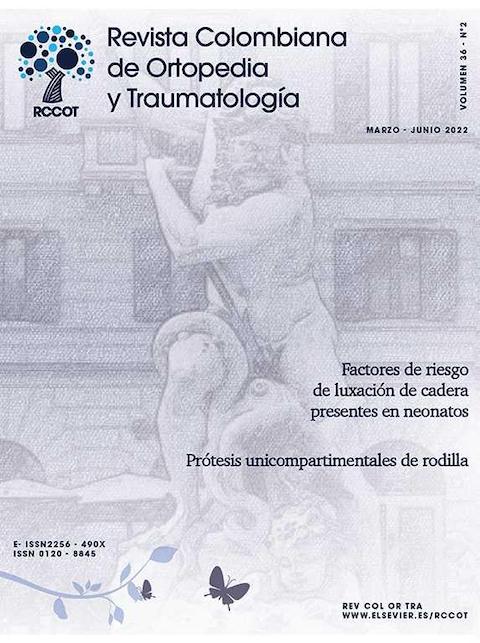Spondylodiscitis and epidural abscess due to Chryseobacterium indologene
DOI:
https://doi.org/10.1016/j.rccot.2022.05.001Keywords:
Discitis, Epidural abscess, SpondylodiscitisAbstract
Introduction: Spondylodiscitis is the infection of the vertebral plates, which can extend to the intervertebral disc and generate an epidural abscess. More frequent in the lumbar spine, then dorsal and finally cervical. From 2 to 7% of bone infections, mortality rate from 1 to 20%. Hematogenous spread (common). The most common germ is Staphylococcus aureus, followed by Streptococcus, Mycobacterium tuberculosis, and Enterobacteriaceae. Chryseobacteria are aerobic gram-negative rods Chryseobacterium indologenes is the most frequent, common in immunocompromised patients.
Clinical case: 55-year-old male with a history of lumbar surgery in 2014, due to degenerative pathology. He presented a surgical site infection and a surgical toilet was performed, without obtaining germ, empirical antibiotic treatment (ciprofloxacin and TMS). Years later he presented progressive lumbar and radicular pain. Loosening of the radiological implant, and spondylodiscitis in MRI. Biopsy under CT, Staphylococcus epidermidis, sensitivity (ciprofloxacin and rifampicin). Abscess is drained and prosthesis removed. Positive cultures for C. indologenes, susceptibility (levofloxacin and rifampicin).
Conclusion: Epidural abscess is a rare but potentially devastating condition. Treatment is determined by the neurological status and condition of the patient.
Downloads
References
Pintado-García V. Infectious spondylitis. Enferm Infecc Microbiol Clin. 2008;26:510-7.
Patricio Manzone. Diagnóstico de infecciones raquídeas. Compendio de patología de columna SILACO Modulo 8. Pag 205 ISBN 978-958-56870-4-2.
Miksi´c NG, Kljai´c Duji´c M, Rejc Marko J, Vorˇsiˇc M, But I. Bacteroides fragilis sacral spondylodiscitis and epidural abscess after sacrocolpopexy: a case report and literature review. J Int Med Res. 2019;47:4568-74, http://dx.doi.org/10.1177/0300060519866270.
Charles N, de Leeuw. Lumbar Epidural Abscesses.USA. Global Spine Journal. 2018;8(4S):85S-95S.
Dornes RR, Vázquez MY, Castañeda ÁMM, Griñán FEM, Nájera PJC. Tuberculous spondylodiscitis. Case presentation. Mediciego. 2017;23:23-9.
Reihsaus E. Spinal epidural abscess: a meta-analysis of 915 patients. Germany. Neurosurg Rev. 2000;23:175-204.
Sakurada A. Retrato Microbiológico. Chryseobacterium indologenes. Rev Chil Infect. 2008;25:446.
Izaguirre-Anariba D, Sivapalan V. Chryseobacterium indologenes, an Emerging Bacteria: A Case Report and Review of Literature Cureus. 2020 21;12:e6720, http://dx.doi.org/10.7759/cureus.6720.
Pola E, Autore G, Formica VM, Pambianco V, Colangelo D, Cauda R, Fantoni M. New classification for the treatment of pyogenic spondylodiscitis: validation study on a population of 250 patients with a follow-up of 2 year. Eur Spine J. 2017;26 Suppl 4:479-88, http://dx.doi.org/10.1007/s00586-017-5043-5.
Mukerji R, Kakarala R, Smith SJ, Kusz HG. Chryseobacterium indologenes: an emerging infection in the USA. BMJCase Rep;. 2016, http://dx.doi.org/10.1136/bcr-2016-214486.bcr2016214486.
Lasa I, Del Pozo JL, Penadés JR, Leiva J. Bacterial biofilms and infection. An Sist Sanit Navar. 2005;28:163-75, http://dx.doi.org/10.4321/s1137-66272005000300002.
Pájaro CTE, Rojas MFV. Espondilodiscitis por Chryseobacterium indolgenes. Revista Colombiana de Medicina Física y Rehabilitación. 2016;26:180-3.





